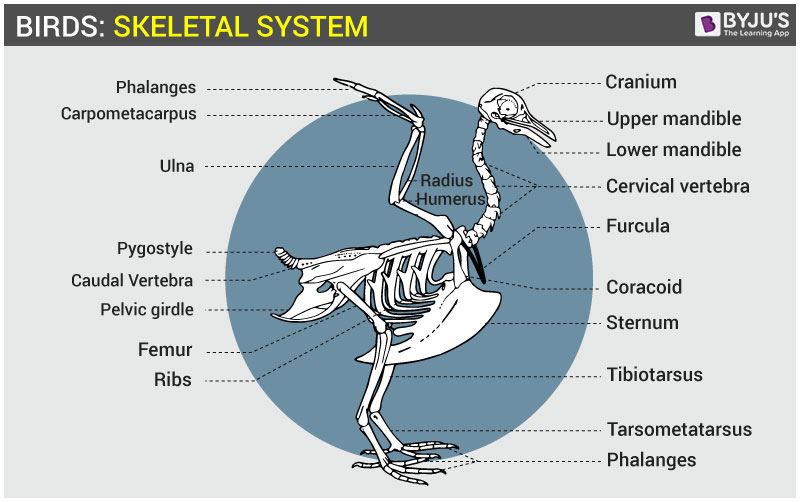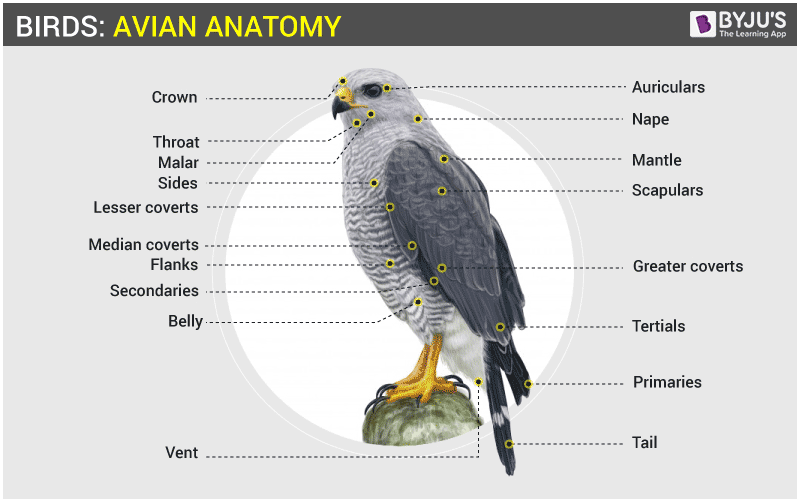|
|
Post by oldcyansilverback on Jan 12, 2023 15:10:05 GMT -5
Basic bird body structure:  |
|
|
|
Post by oldcyansilverback on Jan 13, 2023 19:33:15 GMT -5
|
|
|
|
Post by oldcyansilverback on Jan 15, 2023 5:52:59 GMT -5
|
|
|
|
Post by Gorilla king on Feb 4, 2023 23:43:47 GMT -5
Joe Rogan on birds being the meanest animals:
|
|
|
|
Post by oldcyansilverback on Feb 5, 2023 5:05:59 GMT -5
Birds - Skeletal System.All the vertebrate animals possess skeleton as it helps them in providing support and plays a vital role in protecting both interior organs and their tissues. The Birds skeletal system resembles that of other animals but it is too light weighed, which is required by them to fly while having necessary body support. Birds are creatures gifted with the flying ability and their body structure is also made up so. Even though the avian skull and limb structure resemble human system, their skeletal systems are different. Avian skeletal systems are modified according to their usage.  As compared to mammals, the skeletal system of birds is light weighted. But they are sufficiently strong to overcome the stresses they face during flight and landing. Also, the numbers of bones are far lesser than reptiles and mammals. Bones of birds are hollow which makes them light-weighted while internal struts or cross walls make them strong. But penguin-like birds have solid bones, hence, they can’t fly. Hollow bones contain air spaces in them. These allow more oxygen absorption and provide the extra energy needed for flight. Numerous bones fused together to reduce the count and make the bird’s skeleton rigid. Breastbone (keel-shaped sternum) its large surface area provides the attachment for muscles for flight. Breast bones are fused collarbones (furcula or wishbone). Here are some unique features of Birds – Skeletal System. The vertebral sections of the bird’s backbone are fused together to provide the rigidity which is required for them to flight. The skull size of the birds is proportionally smaller compared to the other species and this helps birds to fly easily. The Skeletal System of birds includes various hollow bones with crisscrossing reinforcements for structural strength. Birds lack teeth and have a beak which is more lightweight. Birds have a fused collarbone, attached to the site of the muscles used for flight. Avian Anatomy. The avian respiratory system consists of hollow bones with air cavities called pneumatic bones. These include skull bones and trunk bones. Skull bones are continuous with nasal cavities. Trunk bones involve vertebrae, pelvic bones, and breastbones. The number of cervical bones (neck bones) is much more than mammals. Around 13 to 25 cervical bones are present in them and their flexibility helps to brush their feathers. Medullary bones like shoulder bones, pubic bones, limb bones is another vital bones. They are the source of calcium in egg-laying birds. Calcium provided by medullary bones makes eggshells thick and strong. Aves are toothless vertebrates so they do not have heavy or strong jaws. Limb organizations in aves are much similar to humans with modifications. The majority of them have four toes but in some count limited to three. Although the number of toes is the same their arrangements vary in different types. For instances, birds like parrots, owls, etc. out of four, two toes pointed forward and two at back while in perching ones three are at the front and one at back. For more detailed information about the Bird’s skeletal system, visit BYJU’S. byjus.com/biology/birds-skeletal-system/
|
|
|
|
Post by oldcyansilverback on Jul 27, 2024 5:16:29 GMT -5
|
|
|
|
Post by oldcyansilverback on Sept 13, 2024 8:41:08 GMT -5
|
|
|
|
Post by oldcyansilverback on Sept 13, 2024 8:49:45 GMT -5
Skeletal muscle and metabolic flexibility in response to changing energy demarnds in wild birds.Abstract Phenotypically plastic responses of animals to adjust to environmental variation are pervasive. Reversible plasticity (i.e., phenotypic flexibility), where adult phenotypes can be reversibly altered according to prevailing environmental conditions, allow for better matching of phenotypes to the environment and can generate fitness benefits but may also be associated with costs that trade-off with capacity for flexibility. Here, we review the literature on avian metabolic and muscle plasticity in response to season, temperature, migration and experimental manipulation of flight costs, and employ an integrative approach to explore the phenotypic flexibility of metabolic rates and skeletal muscle in wild birds. Basal (minimum maintenance metabolic rate) and summit (maximum cold-induced metabolic rate) metabolic rates are flexible traits in birds, typically increasing with increasing energy demands. Because skeletal muscles are important for energy use at the organismal level, especially to maximum rates of energy use during exercise or shivering thermogenesis, we consider flexibility of skeletal muscle at the tissue and ultrastructural levels in response to variations in the thermal environment and in workloads due to flight exercise. We also examine two major muscle remodeling regulatory pathways: myostatin and insulin-like growth factor -1 (IGF-1). Changes in myostatin and IGF-1 pathways are sometimes, but not always, regulated in a manner consistent with metabolic rate and muscle mass flexibility in response to changing energy demands in wild birds, but few studies have examined such variation so additional study is needed to fully understand roles for these pathways in regulating metabolic flexibility in birds. Muscle ultrastrutural variation in terms of muscle fiber diameter and associated myonuclear domain (MND) in birds is plastic and highly responsive to thermal variation and increases in workload, however, only a few studies have examined ultrastructural flexibility in avian muscle. Additionally, the relationship between myostatin, IGF-1, and satellite cell (SC) proliferation as it relates to avian muscle flexibility has not been addressed in birds and represents a promising avenue for future study. www.ncbi.nlm.nih.gov/pmc/articles/PMC9353400/
|
|
|
|
Post by oldcyansilverback on Sept 14, 2024 6:30:45 GMT -5
|
|